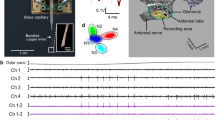Summary
Electrical response of excitable internodal cell ofNitella was studied by applying various kinds of odorants to the cell. Changes in membrane potential and resistance during responses induced by odorants were measured intracellularly under a variety of ionic environments in the media. Results were: 1) Some odorants (coumarin, isoamylacetate, methylacetate, 1-octanol, 1-butanol, 1-propanol) produced an all-or-nothing type action potential when the concentration of odorant exceeded a certain threshold. The action depended on the odorant concentration,C. Other odorants (heptanoic acid, β-ionon) induced gradual depolarization of the membrane potential without evoking an action potential. 2) Membrane resistanceR m changed in various ways during depolarization: some odorants led to a temporal or gradual decrease inR m, and others caused an increase inR m when the membrane potential was depolarized by the application of odorants. 3) Magnitude of response to odorantsOR was found to be represented by the following equation:
where α and β are constants for a given odorant,I the ionic strength in the medium, andC th the threshold concentration of the odorant. 4) Plots of olfactory threshold of human and of internodal cell ofNitella gave a straight line having slope unity. 5) Local application of odorants on the internodal cell induced impulses which transmitted from the part treated by odorants to the other portion. Physico-chemical and physiological implications of the results obtained were discussed.
Similar content being viewed by others
References
Arvanitaki, A., Takeuchi, H., Chalazonitis, N. 1967. Specific unitary osmereceptor potentials and spiking patterns from giant nerve cells.In: Olfaction and Taste. T. Hayashi, editor. Vol. 2, p. 573. Pergamon Press. Oxford
Beidler, L.M. 1954. A theory of taste stimulation.J. Gen. Physiol. 38:133
Beidler, L.M. 1965. Comparison of gustatory receptors, olfactory receptors, and free nerve endings.Cold Spring Harbor Symposia on Quantitative Biology 30:191
Dowson, W.W. 1962. Chemical stimulation of the peripheral trigeminal nerve.Nature 196:341
Dethier, V.G. 1972. Sensitivity of contact chemoreceptors of blowfly to vapors.Proc. Nat. Acad. Sci. USA.69:2189
Inoue, I., Ishida, N., Kobatake, Y. 1973. Studies of excitable membrane formed on the surface of protoplasmic droplets isolated fromNitella. 4. Excitability of drop membrane in various compositions of the external salt solution.Biochim. Biophys. Acta 330:27
Kamo, N., Miyake, M., Kurihara, K., Kobatake, Y. 1974. Physicochemical studies of taste reception. Parts 1 and 2.Biochim. Biophys. Acta 367:1, 11
Kishimoto, U. 1966. Repetitive action potentials inNitella internodes.Plant Cell Physiol. 7:547
Koyama, N., Kurihara, K. 1972. Effect of odorants on lipid monolayer from bovine olfactory epithelium.Nature 236:402
Osterhout, W.J.V., Hill, S.E. 1930. Negative variations inNitella produced by chloroform and by potassium chloride.J. Gen. Physiol. 13:459
Tazawa, M. 1964. Studies onNitella having artificial cell sap. 1. Replacement of the cell sap with artificial solutions.Plant Cell Physiol. 3:33
Tazawa, M. 1972. Membrane characteristics as revealed by water and ionic relations of Alogal cells.Protoplasma 75:427
Tucker, D. 1971. Nonolfactory responses from the nasal cavity: Jacobson's organ and the trigeminal system.Handbook of Sensory Physiol. L.M. Beidler, editor. Vol. 4-1, pp. 151–181. Springer-Verlag, New York
Ueda, T., Muratsugu, M., Kurihara, K., Kobatake, Y. 1975. Olfactory response in excitable protoplasmic droplet and internodal cell ofNitella.Nature 253:629
Ueda, T., Terayama, K., Kurihara, K., Kobatake, Y. 1975. Threshold phenomena in chemoreception and taxis by slime moldPhysarum polycephalum.J. Gen. Physiol. 65:223
Author information
Authors and Affiliations
Rights and permissions
About this article
Cite this article
Ueda, T., Kurihara, K. & Kobatake, Y. Response ofNitella internodal cell to chemical stimulation. J. Membrain Biol. 25, 271–284 (1975). https://doi.org/10.1007/BF01868579
Received:
Revised:
Issue Date:
DOI: https://doi.org/10.1007/BF01868579




